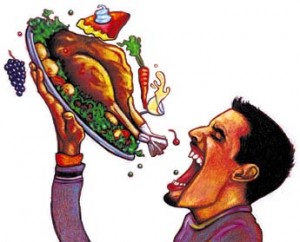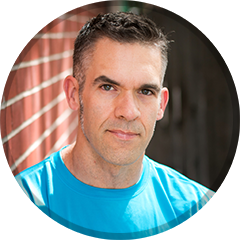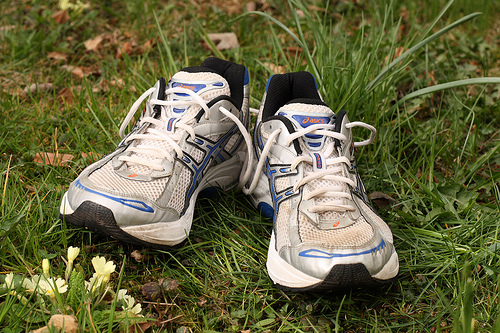
Artwork: St. Petersburg Times, FL
A day of severe gluttony is headed our way like a runaway chuck wagon. Therefore, how about a discussion of two articles on obesity? For the Overweight, Bad Advice by the Spoonful was published back in August of this year in the New York Times Health Guide. The other, Energy Gap Useful Tool for Successful Weight Loss Strategy is from early November in Science Daily. The two articles present very daunting insights into our fight against obesity. The Times piece tells us the following:
- Weight control is not simply a matter of willpower. Genes help determine the body’s “set point,” which is defended by the brain.
- Dieting alone is rarely successful, and relapse rates are high.
- Moderate exercise, too, rarely results in substantive long-term weight loss, which requires intensive exercise.
The article further states:
“…the notion that Americans ever ate well is suspect. In 1966, when Americans were still comparatively thin, more than two billion hamburgers already had been sold in McDonald’s restaurants, noted Dr. Barry Glassner, a sociology professor at the University of Southern California. The recent rise in obesity may have more to do with our increasingly sedentary lifestyles than with the quality of our diets.”
Our bodies are remarkably stubborn in their ability to keep us at our current weight (discussed further here). We eat smart and healthy one day, a little less so the next. In contrast to the Times article, from everything I read and understand, the food component of weight loss is far more powerful than the exercise component (suggested here, and here). In fact the issue is poor eating plus a sedentary lifestyle that’s gotten our nation so heavy. Things like this are never isolated to one cause. (By the way, body weight isn’t the only measure of health. Look here for more on the issue of fit vs. fat.)
There are two things not mentioned in the Times article that we should consider. First regarding the way we ate decades ago vs. how we eat now is the presence of processed foods. I don’t have statistics but I think it’s safe to assume that in the 1960s we were eating more fresh, unprocessed food. We now eat gobs of food every day that is packed with calories but contains very little actual nutrition. For a sober, practical, in-depth look at our nation’s obsession with “nutritionism” you must read what Michael Pollan says in Unhappy Meals. Another comment on Pollan’s work is found at Disease Proof. (For truly fascinating insights into the American food system, you must read Pollan’s The Omnivore’s Dilemma and/or In Defense of Food.)
The second component of our eating we must consider is portion size. Portion size is a tremendous component of obesity. In recent decades past, our overall calorie intake was lower than it is now, thus there was far less obesity. The article notes the billions of McDonald’s hamburgers that were sold but do you know what those hamburgers looked like? You can still buy it today. If you look at a McDonald’s menu they actually have something simply called a hamburger; not a Big Mac, Quarter Pounder, Titanic Monster Burger, or whatever. It’s a small thing with one meat patty, pickles, onions and ketchup. A customer in the ’60s may have gotten fries and a soft drink, but the fries came in a small paper envelope, not a cardboard crate, and the soft drink was an eight ounce cup rather than an industrial drum.
For more on portion sizes and our consumption habits, the Centers for Disease Control provide a report called Do Increased Portion sizes Affect How Much We Eat? It’s amazing to see how we can unconsciously eat a lot more than we need to if it’s sitting there in front of us.
The Science Daily article tells us that once one is obese, the body fights extra hard to stay there. In contrast, one who never becomes obese seems far less likely to become obese. The article discusses the Energy Gap, a term used by the American Dietetic Association to estimate the change in energy balance (intake and expenditure) behaviors required to achieve and sustain reduced body weight outcomes in individuals and populations. We’re told that the energy gap to prevent weight gain is about 100 calories. That is, someone can prevent weight gain with a combination of reduced energy intake and increased physical activity that amounts to 100 calories. The news isn’t so good for those trying to lose significant amounts of weight. The energy gap may be 200-300 calories for someone looking to lose 10%-15% of their body weight. That means serious eating modification and quite a bit of time exercising.
According to James O. Hill, PhD,
“This analysis indicates that to create and maintain substantial weight loss (ie, obesity treatment), large behavioral changes are needed. This is in stark contrast to primary obesity prevention in which small behavioral changes can eliminate the small energy imbalance that occurs before the body has gained substantial weight. Because the body has not previously stored this ‘new’ excess energy, it does not defend against the behavioral strategies as happens when the body loses weight.”
What does all of this mean? First, obesity is much like any other disease in that preventing it is much easier than treating it once you’ve got it. (This makes the topic extremely relevant to the current health care debate. Preventing obesity will result in prevention of obesity related illnesses, and we’ll all spend less on health care.) Second, there’s much evidence to suggest that losing weight is a complex battle that is more than simply making a decision. We have a very tenacious system wired into us (likely rooted in some prehistoric survival strategy) that makes dropping pounds extremely difficult. It’s akin to telling the drug addict to just stop.
Just stopping–a conscious decision to change a behavior in other words–is still the heart of the issue. Weight loss still comes down to willful decisions to make changes. There’s no way around it. I learned a little bit about human psychology and behavior in graduate school. It seems that most of us adhere to changes if they’re made in small, gradual steps. Just one healthy decision made today is one more than was made yesterday. That’s a step toward whatever healthy goal we have in mind. Keep making healthier daily decisions and over the course of a year, two years, 10 years and you’ll have made a lot of them. Guess what’s around the corner though: the New Year’s Resolution.
We’re getting close to the time of year when many people will make the big decision to lose weight this year. Gyms will be packed with people exercising like they’ve never done before–at least not since the beginning of the previous year. They’ll make attempts to banish their favorite foods from their plates and replace it with food they’ve never much liked. Most of these noble attempts will be abandoned by the end of February. This is the perfect example of people making drastic lifestyle changes which cannot be maintained. As a personal trainer, I see this happen every year.
Speaking from personal experience, I look back to childhood, high school and college and see what I ate and/or drank–and in what amounts–and I’m amazed at the amounts of junk I once consumed. I’ve spent over a decade making changes here and there and I’ve found that it hasn’t been too terribly painful at all. Of course I can’t extrapolate my experience out to everyone else, but it seems to me a strategy of small changes in both eating and exercise made over time, plus the decision to stick with these changes is still the best strategy to lose weight and get healthy. If there’s a better strategy, please let me know.
Beyond that, here’s more to read on a variety of topics:
- Are we Insane? Part II: the Cookie Diet. Does this even need any explanation? Cookies and dieting…. I think I’ll try breathing underwater later today, or maybe flapping my arms and flying. (Ever notice how everyone who was on a diet… WAS on a diet? No one stays on any of these things.)
- To thrive longer, get stronger. The Washington Post discusses Consumer Reports’ findings on various clinical trials of strength training. Turns out picking up heavy objects is good for you in many ways.
- Runners: Train less and be faster. OK, this will be controversial to some and I’m not saying this is true for everyone all the time. However the findings here help support some of the arguments made at Power Running that running fewer miles (low volume) while running faster (high intensity) may increase race performance. Science Daily profiles a report in the Journal of Applied Physiology on the topic of running less but running faster. Again, do not assume this is the be-all-end-all for everyone, but it might be exactly the strategy that will work for you.
- Ice or Heat? The topic of icing or heating an injury is often debated. Like many issues of sports conditioning and rehabilitation, the jury is still out. The following is a reprint of a comment by the late Dr. Mell Siff from the Supertraining forum:
ICE OR HEAT?
by Dr. Mel C SiffThe use of ice treatment may not be universally superior to the use of heat
in enhancing recovery or rehabilitation.
THE PROBLEM
The use of localised or more extensive ice or cold treatment has been well
authenticated over the years and there is little doubt that, in many cases,
it is a highly effective and cheap method of restoration and rehabilitation.
However, any literature searches for definitive studies that compare the
effectiveness of ice cold versus very hot treatment of the same sort of injury are not as common as one would believe.
It seems as if we have all accepted that heat is contraindicated largely on
the basis of theoretical considerations or extrapolations form cases where
bleeding is apparent. We know that heat causes blood vessels dilatation,
temporary increase in inflammation and the decrease in blood viscosity, but
does this necessarily imply that it will be detrimental to the course of
restoration or rehabilitation of all sore, bruised and fatigued soft tissues?
Why I am saying this is because I have been experimenting, much against my
education and scientific traditions, with the use of very hot water as a
restorative means with myself and several other athletes, some of whom are
top pro footballers and basketballers.
Surprisingly, this seems to diminish muscle soreness and speeded up recovery
in many cases, especially if we use alternate hot and cold bathing. I have an
8 ft deep jacuzzi and long lap swimming pool and have my athletes alternate
between hot and cold immersion. Interestingly, I have found that the water
has to be almost unbearably hot (about 108 deg F or 41C) to be optimally
effective. Movement under these conditions also seems to be valuable
(‘cryokinetics’ for ice old immersion and ‘thermodynamics’ for hot
immersion).
Certainly my comments on this controversial topic merely constitute anecdotal
evidence at this stage, but I am curious to hear if anyone else has had
similar experiences or come across scientific research which legitimately
shows that dedicated ice treatment is significantly better than very hot
treatment or ice-heat contrast methods. Failing that, is there any evidence
that the use of heat is a general contraindication for musculoskeletal
recovery and rehabilitation, other than cases where there is obvious bleeding
or serious pathology?
Are we promoting ice therapy far too liberally to the exclusion of heat
therapy, when the latter may well also play a very helpful role in
musculoskeletal rehabilitation? Are we unfairly proclaiming that heat is
potentially harmful for treating any soft tissue repair? Does this attitude
go against our recent attestations to the value of ‘holistic’ treatment?
There have been a huge number of studies on the effect of stretching,
jogging, supplements, heat, cold, drugs, you name it …. and virtually
nothing has yet been found that appears to make some significant and
consistent difference to the dissipation of DOMS. Do a Medline search
and you will see what I mean. Many higher level weightlifters and
ppwerlifters rarely if ever suffer from DOMS even after very heavy
workouts, which afflicts mainly newcomers to a given exercise or
routine – or certain more susceptible individuals. For general recovery,
I have found it difficult to beat sensible program (or periodisation) design and
hot-cold contrast bathing, as I have written in previous letters. Your
recommendation to do some mild post-exercise activity probably is
a sound idea for general relaxation and recovery, but it has not been
shown to have any real effect on DOMS.



